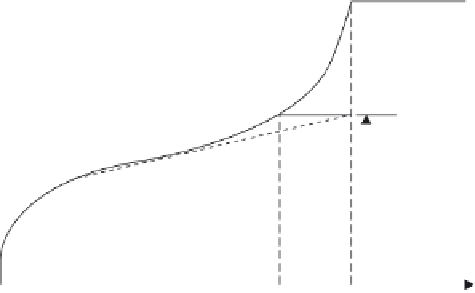Environmental Engineering Reference
In-Depth Information
·
ε
R
=
λε
·
ε
=
ε
s
t
R
t
MGD
t
R
Time,
t
3.23
Representation of creep strain growth following the
Kachanov-Rabotnov model.
.
Phaniraj
et al
.
98
have established a correlation between the ratio of time to
Monkman-Grant ductility (
t
MGD
) and time to rupture (
t
R
) and the damage
tolerance parameter as given by
the creep curve would assume different shapes for different values of
λ
λ
.
⎡
⎢
⎤
⎥
⎤
⎦
λ
1
t
MG
D
−
1
[3.60 ]
⎡
⎣
=−
λ
t
R
t
Figure 3.24 is based on this Equation [3.60] and shows that
t
MGD
/
t
R
is essen-
tially constant for
> 4. The
t
MGD
was suggested as time for onset of true
tertiary creep damage and was considered to be an important parameter in
identifying the useful creep life of a material. It also describes the time for
which minimum creep ductility is ensured. Hence Phaniraj
et al.
contend
that the stress to cause
t
MGD
in 10
5
h can be used as a useful design criterion
for creep of elevated temperature components.
Before concluding we present a few examples where the concepts dis-
cussed in the previous sections may not be directly applied. Rather subtle
modifi cations to the models are necessary in order to simulate the actual
behavior of the material.
λ
3.7
Case studies illustrating the role of other factors
In the following section, the effects of impurities, second phases and multi-
axial loadings on creep of materials are discussed with examples taken from
various classes of materials including ionic solids.














Search WWH ::

Custom Search